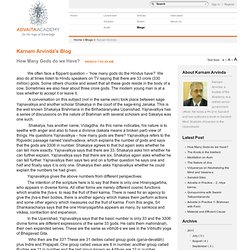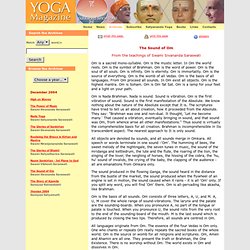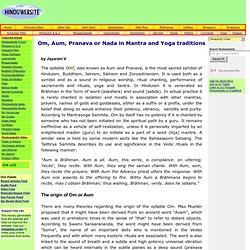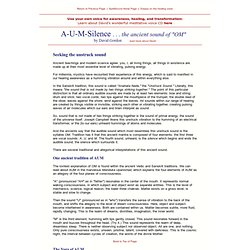

Meditation on Aum. We often face a flippant question – ‘how many gods do the Hindus have?’

We also do at times listen to Hindu speakers on TV saying that there are 33 crore (330 million) gods. Some others chuckle and assert that all these gods reside in the body of a cow. Sometimes we also hear about three crore gods. The modern young man is at a loss whether to accept it or leave it. A conversation on this subject (not in the same vein) took place between sage Yajnavalkya and another scholar Shakalya in the court of the sage-king Janaka. Shakalya, has another name, Vidagdha. Yajnavalkya gives the above numbers from different perspectives. The intention of the scripture here is to say that there is only one Hiranyagarbha, who appears in diverse forms. In the Upanishad, Yajnavalkya says that the basic number is only 33 and the 3306 divine forms are different expressions of the same 33 gods.
Who then are the 33? Such classification is from the perspective of the functions of the three groups. Mandala Yoga Ashram - LE MANTRA OM. Le mantra OM (ou AUM) nous a été transmis par les sages des Himalayas. C'est le mantra le plus important du yoga. Selon la tradition, chaque « chose » manifestée est issue de cette vibration sonore première qui est symbolisée par Om. The Sound of Om. Om is a sacred mono-syllable.

Om is the mystic letter. In Om the world rests. Om is the symbol of Brahman. OM et Yoga du son et Chant Harmonique... L'art des mantra. La Syllabe Sacrée " OM", ou "AUM" symbolise le Son primordial, le Verbe éternel créateur.

Source du commencement des temps," OM" contient tout ce qui a été, est, et sera. Il est l’essence de l'univers entier. C'est le Mantra le plus précieux qui soit, le Mantra des mantras. Le pouvoir de la Syllabe Sacrée Psalmodié par les plus grands sages de l’Inde et du Tibet, Pranava OM est souvent comparé à la flèche dont la pointe est la pensée traversant les ténèbres de l’ignorance pour atteindre la lumière de l’état suprême.
Celui qui connaît OM est le sage véritable. Pranava OM est le Plus important des Mantra du Yoga. OM est la pulsation de l’univers, la forme sonore de "ATMA" (la Conscience) Maitri Upanishad. Cependant il ne s’agit pas de croire que le son audible est Dieu car il ne l’est pas. Om, Aum, Pranava or Nada in Mantra and Yoga traditions. By Jayaram V The syllable Om1, also known as Aum and Pranava, is the most sacred symbol of Hinduism, Buddhism, Jainism, Sikhism and Zoroastrianism.

It is used both as a symbol and as a sound in religious worship, ritual chanting, performance of sacraments and rituals, yoga and tantra. In Hinduism it is venerated as Brāhman in the form of word (askshara) and sound (sabda). In actual practice it is rarely chanted in isolation and mostly in association with other mantras, prayers, names of gods and goddesses, either as a suffix or a prefix, under the belief that doing so would enhance their potency, vibrancy, sanctity and purity. According to Mantrayoga Samhita, Om by itself has no potency if it is chanted by someone who has not been initiated on the spiritual path by a guru.
"Aum is Brāhman. The origin of Om or Aum There are many theories regarding the origin of the syllable Om. Historical development Pranava and Udgita. RUSSILL PAUL: OM AND CONSCIOUSNESS. A-U-M-silence. Seeking the unstruck sound Ancient teachings and modern science agree: you, I, all living things, all things in existence are made up at their most essential level of vibrating, pulsing energy.

For millennia, mystics have recounted their experience of this energy, which is said to manifest in our hearing awareness as a humming vibration around and within everything else. In the Sanskrit tradition, this sound is called "Anahata Nada," the "Unstruck Sound. " Literally, this means "the sound that is not made by two things striking together. " The point of this particular distinction is that all ordinary audible sounds are made by at least two elements: bow and string; drum and stick; two vocal cords; two lips against the mouthpiece of the trumpet; the double reed of the oboe; waves against the shore; wind against the leaves.